Yesterday, the White Sox made their second move of the offseason, signing Andrew Benintendi to a five-year, $75M contract – making his contract the highest guaranteed free agent contract in White Sox history.
With the move, the White Sox now have their left fielder for the foreseeable future while providing Eloy Jimenez and Andrew Vaughn the ability to play the positions they are best suited for. The former first-round draft pick (one pick before Carson Fulmer) hit .304/.373/.399 last season between Kansas City and New York – what should White Sox fans expect from him in Chicago? How should we grade this move?
Here’s a breakdown of the move that analyzes Benintendi’s contract, who he is as a player, some concerns about the signing, and how he fits on the 2023 White Sox.
The Contract
The deal, as mentioned, is five years for $75M with no mention of any opt-outs. The contract structure itself is interesting, however, as it is backloaded for the first time that I can remember in recent White Sox history:
- 2023: $8M (+$3M signing bonus)
- 2024-2026: $16.5M
- 2027: $14.5M
Backloading this contract signals one of two things:
- The White Sox will now have a little extra money to spend in free agency (maybe $5-$7M)
- The White Sox needed to structure the contract this way in order to make the contract work this year
It could be one of the two, or somehow a combination of both. We won’t know for sure until the rest of the offseason unfolds. If it’s option 1, look for the team to sign a fourth outfielder, veteran second baseman, or backup catcher as they work to complete the roster. If it’s option 2, well, let’s hope the trade market becomes fruitful.
All that said, at first glance, this deal goes along with the evolving free agent market. With players like Carlos Correa, Carlos Rodon, and Trea Turner, as well as Bryce Harper from years past, the trend is clear: players prefer more guaranteed years on their contract, even if it means accepting a lower AAV than they might be expected to get. In a way, players seem to be a little more risk-averse, in that they are a bit more concerned about making sure they get the long-term value they are hoping for. There is nothing “right” or “wrong” about that – this is simply how the market is going.
Here are some comparison contracts for Benintendi based on the past few seasons of multi-year deals:
| Player | Years | Salary | AAV | Previous Season fWAR |
|---|---|---|---|---|
| Brandon Nimmo | 8 | $162M | $20.25 | 5.4 (2022) |
| Chris Taylor | 4 | $60M | $15M | 3.0 (2021) |
| Andrew Benintendi | 5 | $75M | $15M | 2.8 (2022) |
| Mitch Haniger* | 3 | $43.5M | $14.5M | 0.8 (2022) |
| Avisail Garcia | 4 | $53M | $13.25M | 2.8 (2021) |
FanGraphs Roster Resource, which gives fans the opportunity to gauge what they think players will make, projected Benintendi at four years and $56M ($14M AAV). Given that he took the fifth year – which, I think most would agree is one year more than expected on his contract – it’s likely he left some money on the table in terms of AAV, so there could be some potential surplus value in this contract. But with Nimmo, Taylor, Haniger, and Garcia all serving as multi-year highs and lows for Benintendi’s value, it’s pretty clear that no matter how way you slice this up, this is a pretty fair market value deal for Benintendi given the production he has put up recently.
Beyond the actual contract itself, there have been plenty of narratives surrounding the fact that Benintendi – a player most consider average to above average – was somehow given the largest contract in White Sox history. This has been a source of aggravation for a lot of fans, but in reality, this is a product of two things: (1) an ever-evolving free-agent market, and (2) the White Sox’s historical lack of large guaranteed contracts. $15M AAV and $75M guaranteed are not groundbreaking numbers. For most teams, this wouldn’t even be near the largest contract ever given to a player. For the White Sox, however, the philosophy has long been putting money into three or four players instead of paying a lot of money to one player. This is how we get here.
So, as the market shifts and player contract values naturally rise, it’s really not worth the anguish over being the biggest contract in White Sox history. It says so little about the player while saying so much about the White Sox organization. These are contracts that the White Sox should always be trying to sign good players to.
The Player
I’ll start by saying I’ve long been a fan of Benintendi the player – I like how his profile complements this team. But let’s dive into it.
In 2022, Benintendi posted a slash line of .304/.373/.399 (.772 OPS) with five home runs and 51 runs batted in. While these aren’t numbers that really jump off the paper, Benintendi is the sort of player that the White Sox were missing in 2022:
- Left-handed production to balance out the lineup (career 116 wRC+ vs. RHP)
- Strong walk rate (career 9.8% walk rate; 74th percentile BB% in 2022)
- Improved defense in the outfield (0 OAA in 2021, -1 OAA in 2022)
- Strong swing/take profile (84th percentile in chase rate, 75th percentile in whiff rate)
So, he checks a lot of boxes at a price the White Sox were clearly comfortable paying. Let’s dive a little bit deeper into the 2022 version of Benintendi because, in many ways, it looked a lot different than previous seasons – in a good way.
2022 Hitter Profile Changes
With Mike Tosar and Pedro Grifol coming over from Kansas City, Benintendi’s 2021 and 2022 seasons with the Royals should be of particular interest to White Sox fans. While the power numbers aren’t jumping off the map, his past two seasons have been encouraging. In 2021, he posted the highest hard-hit rate of his career, and in 2022, he followed it up with the second-highest hard-hit rate of his career.
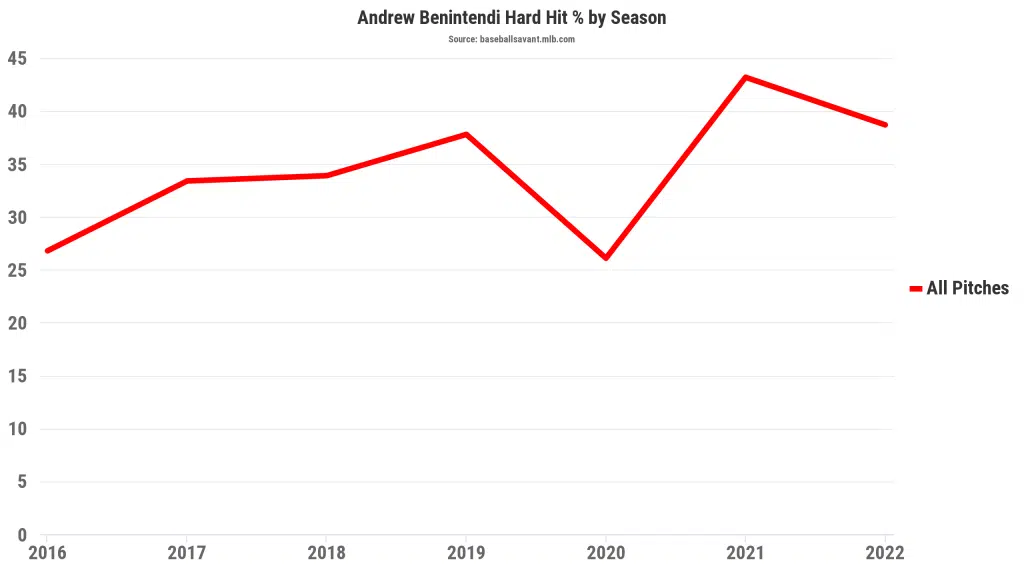
It was his general swing profile, however, that makes him the most interesting heading into 2023. In 2022, Benintendi posted a career-low strikeout rate (14.5%) while posting a walk rate that was right around his career averages (10.0%). What helped to contribute to this was a clear step forward in the plate discipline department that helped to match some numbers he saw during some of his best days in Boston.
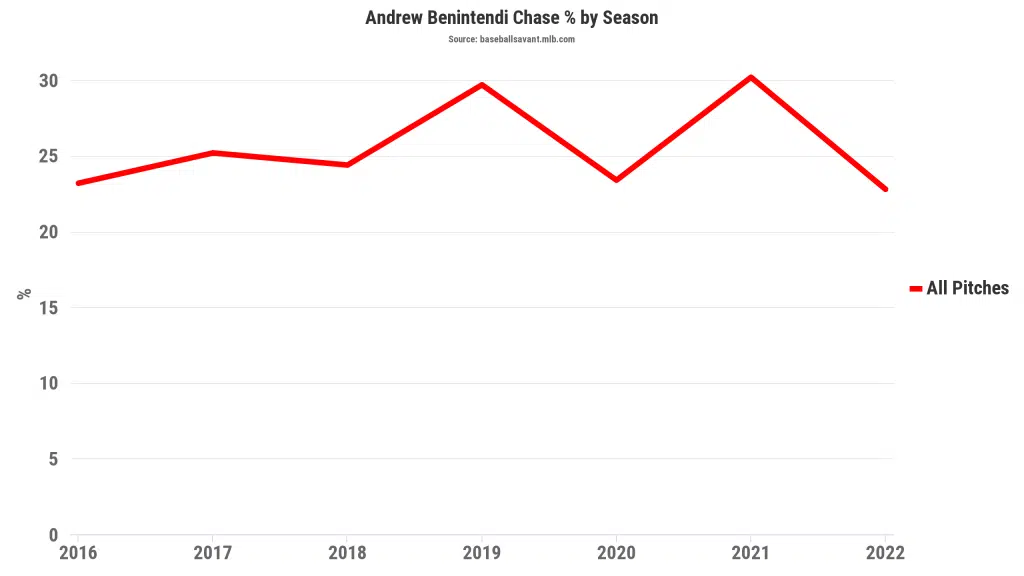
| O-Swing % | Z-Swing % | O-Contact % | Z-Contact % | SwStr % | |
|---|---|---|---|---|---|
| Benintendi | 27.9% | 74.9% | 73.4% | 85.5% | 8.9% |
| Rank (out of 130) | 35th | 23rd | 21st | 86th | 43rd |
| MLB Average | 32.6 | 69.1 | 63.5 | 85.3 | 11.1 |
Some quick definitions for those unfamiliar:
- O-Swing %: percentage of pitches outside of the zone a player swings at
- Z-Swing %: percentage of pitches inside of the zone a player swings at
- O-Contact %: percentage of pitches outside of the zone a player swung at AND made contact with
- Z-Contact %: percentage of pitches inside of the zone a player swung at AND made contact with
- SwStr %: Swinging Strike Percentage
Benintendi showed incredible pitch recognition and bat-to-ball skills in 2022. He is among the best in baseball in laying off of pitches out of the zone, and even the pitches he swings at out of the zone he is hitting nearly 75% of the time. His O-Swing % dropped from 34.6% in 2021 to 27.9% in 2022, which helped boost his walk rate from the career-low 6.7% he posted in 2021. In terms of his chase rates and general plate discipline, these were some of the best numbers Benintendi put up since his breakout campaign in 2018 with the Red Sox.
In looking just at a high level at Benintendi’s swing % by zone from 2021 to 2022, we see that his high-level numbers – in particular, his .373 OBP – were in fact accompanied by a clear change in plate approach that included improved plate discipline.
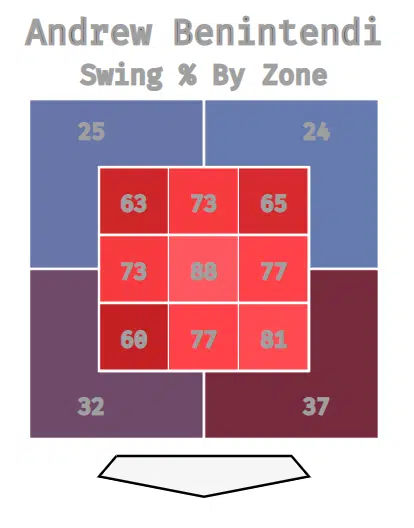
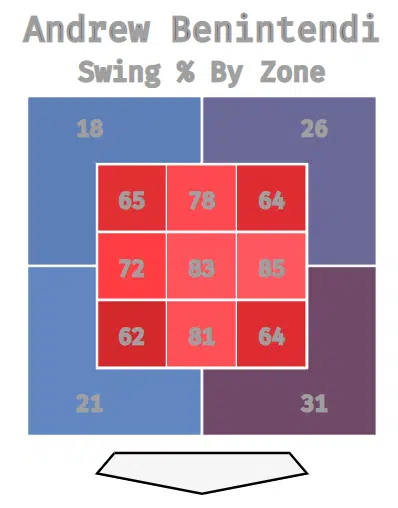
However, let’s break this down a bit further just to show how valuable Benintendi’s plate discipline was last season. Baseball Savant has what is called a Swing/Take profile for hitters, which gives a sense of a hitter’s production via swinging and not swinging at pitches in four zones: Heart, Shadow, Chase, and Waste zones, which are shown below.

Here is what Benintendi’s profile looked like in 2022 in the form of rankings:
| Heart | Shadow | Chase | Waste | |
|---|---|---|---|---|
| Swing Runs Rank | 181st | 137th | 42nd | 167th |
| Take Runs Rank | 97th | 40th | 74th | 170th |
| Total Runs Rank | 177th | 133rd | 43rd | 177th |
As evidenced by his 25th percentile barrel % and 53rd percentile average exit velocity, Benintendi has never really hit the ball hard enough to be a true force in the Heart of the zone like true sluggers. Instead, Benintendi creates his value primarily in the Chase zone. He was able to identify the difference between hittable and unhittable pitches, and even when swinging at more unhittable pitches, he created value, ranking 7th in wOBA in the Chase zone in 2022:

This general profile mimics players such as Brandon Nimmo, Cavan Biggio, Gavin Lux, and (to a much lesser degree) Juan Soto, so it’s clear what the White Sox were going for by acquiring a player such as Benintendi: someone who can create value with strong plate discipline and selectiveness.
However, while there were still plenty of positives from these changes, Benintendi has hit 20 homers in a season before and 40+ doubles; certainly, he has more power in his bat than he’s shown in Kansas City, right?
That being said, could some of these changes above, and as a result, the power outage, have been due to the environment he was playing in?
Some Potential Power?
The ballpark a player plays 81 of their games in at home has a large effect on their power output. In 2021 and 2022, Benintendi played his home games in Kauffman Stadium, which is notorious for being a poor hitter’s park in terms of the long ball. Specifically, in Benintendi’s past two seasons in Kansas City, Kauffman Stadium has been one of the worst ballparks for home run hitters in the league, per Baseball Savant’s Ballpark Factors, ranking 3rd-worst for lefties in 2021 and 8th-worst in 2022.
How exactly does that affect power output? Well, take a look at expected home run numbers (xHR) for Benintendi’s last two seasons in Kauffman Stadium versus Guaranteed Rate Field based on launch angle, exit velocity, and similarly hit balls.
| Year | HR | xHR (KCR) | xHR (CHW) | Difference |
|---|---|---|---|---|
| 2021 | 17 | 13 | 29 | +16 |
| 2022 | 5 | 5 | 10 | +5 |
Now, this should be taken with some caution, as it assumes ALL games took place in KC and Chicago. However, what this chart does show is an extreme difference in the hitter’s environment – and in particular, one that would be friendly to Benintendi’s profile as a hitter.
Comparing the Ballpark Factors for Kauffman Stadium and Guaranteed Rate Field takes these comparisons a step further. Note that 100 here is average, and every percentage point above and below 100 represents X% more/less home runs observed at that ballpark. So, a ballpark factor of 150 would mean that 50% more home runs are observed at that ballpark.
Here are the Ballpark Factors on HR for left-handed hitters over the past two seasons:
| Ballpark | 2021 Park Factor | 2021 Rank | 2022 Park Factor | 2022 Rank | 2020-2022 Rank |
|---|---|---|---|---|---|
| Kauffman Stadium | 71 | 28th | 81 | 23rd | 28th |
| Guaranteed Rate Field | 164 | 2nd | 145 | 3rd | 3rd |
The differences here are striking. In fact, over the past three seasons, Guaranteed Rate Field has actually been the third-best ballpark for left-handed hitters to hit home runs – perhaps showing why so many people would like to see the White Sox with more left-handed hitters in the lineup. Kauffman Stadium over the same time period? Third-worst. What Kauffman Stadium is good for, however, is extra-base hits and hits in general – which fit Benintendi’s exit velocity numbers well. Perhaps that’s why Mike Tosar and others led Benintendi to lean into that approach in 2022.
For fun: Fenway Park, from 2017-2019 when Benintendi was a prominent part of the Red Sox lineup, was the fourth-worst ballpark for left-handed hitters to hit home runs. The Monster in left field combined with the incredibly deep right-center field triangle helps to explain that. However, could it also help to explain some of why Benintendi never could – or never tried to – develop some of the power that made him such a slugger in college (20 HR in 65 G and a .717 SLG)?
Now, this isn’t to suggest that Benintendi is going to come to the White Sox and become a slugger. While he has plenty of work of his own to do here in the power department (he posted a career-low 30.5% pull rate in 2022), there seems to be enough evidence to suggest that perhaps simply a change in environment will help Benintendi more than it may seem at first.
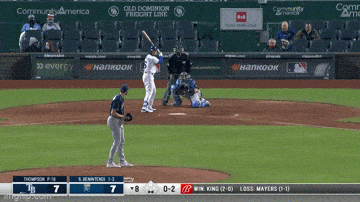
For more fun: the fly ball in the video above had an xwOBA of 1.567. It would have left 18 parks – including Guaranteed Rate Field (via @would_it_dong).
The Effect of the Shift Ban
As has been widely talked about this offseason, starting in 2023, Major League Baseball is going to ban the shift by forcing two players to be on either side of second base and standing on the infield dirt. The question talked about quite often is: how will left-handed hitters be affected in 2023? The general theory is, for most hitters, there will be some sort of boost without the use of exaggerated shifts.
Andrew Benintendi, should this theory hold, would also be a beneficiary of increased production thanks to the banning of shifts.
| PA | % of PA | wOBA | |
|---|---|---|---|
| Shifts | 231 | 44.5% | .318 |
| Non-Shifts | 288 | 55.5% | .363 |
The difference in wOBA between situations in which he was shifted upon and not shifted upon in 2022 is pretty drastic, and while it is unclear just what sort of benefit Benintendi (or any left-handed hitter) may see in 2023, it’s fair to theorize that some of Benintendi’s hard luck outs from last season will find some grass in 2023.
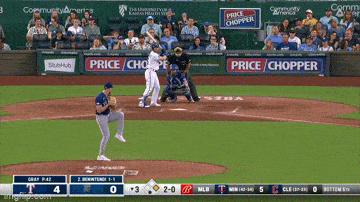
There is still some work Benintendi can do himself here – his 12.6-degree average launch angle would suggest there is at least a little bit of extra loft Benintendi could work to bring to his swing, especially in an improved hitter’s park in Guaranteed Rate Field. Perhaps even just a degree or two of additional loft, combined with his current plate discipline, could be the key to maximizing his offensive output.
Potential Concerns
While there are plenty of things to like about Benintendi’s game and what he will be bringing to the South Side, as some fans have pointed out, there are things to be concerned about.
Let’s start with the most obvious one: Benintendi is a corner outfielder who has never shown a lot of power. The reason? Benintendi just doesn’t hit the ball that hard; his barrel % and exit velocity rankings are in the middle of the pack. In addition, while his plate discipline improved drastically in 2022, his slugging percentage dropped below .400 for the first time in a full season while supporting a career-high BABIP of .352 (though, with a career BABIP of .324, this isn’t as concerning as it sounds at first, but is absolutely something to monitor). While there is plenty to suggest that Benintendi may be able to find some additional power output playing in a more hitter-friendly ballpark, those are just that: suggestions. If Benintendi is really only a 5-10 HR hitter moving forward, he will need to continue to post career-high numbers in AVG and OBP as he did last season to remain productive. That’s a tall task to ask of any hitter.
In addition, an element of Benintendi’s game that hasn’t appeared in recent seasons is his speed. This season, he saw his sprint speed fall to just the 53rd percentile after consistently being in the 65th percentile or higher throughout the beginning of his career. He has twice stolen 20+ bases in a season (2017-2018) but hasn’t stolen more than 10 in a season since. This fact, accompanied by that fall in sprint speed, becomes important in trying to project how an important element of his game may evolve as he gets older. He will turn 29 mid-season this year, so he’s not exactly old, but can the White Sox count on Benintendi to be a speed threat at the top of a projected lineup? As of right now, that’s not particularly clear.
This lack of speed doesn’t just affect the offensive side of Benintendi’s game – it can trickle over into his defense as well. At current, it appears Benintendi is an average defender at best. He’s had a solid season before, posting +4 Outs Above Average (OAA) in 2018, but given the rest of his career numbers, it appears that may indeed be an outlier. In 2021 and 2022, he posted 0 and -1 OAA, respectively, so the word “average” is actually pretty perfect here. Defensive Runs Saved (DRS) actually likes Benintendi’s defense a lot more, ranking him as the second-best left fielder in 2021 (+7 DRS) and ninth-best left fielder in 2022 (+2 DRS). So, let’s just call it a split at best. On the positive side, having Luis Robert playing next to him in a much smaller outfield should help Benintendi, but until this is seen in the numbers, there will be concerns about both his defense and arm strength (49th percentile).
Health is also worth mentioning here, as he has missed time over the past two seasons due to a right rib fracture (2021) and right wrist inflammation (2022). A rib injury was part of what caused him to miss the entire 2020 season as well. However, he does have a pretty good history of playing in 130-150 games; hopefully, it will be closer to the high end of the range. The injury situation will at least be something to monitor. All that being said, he should still age well, and the White Sox paying him for his age 29-33 seasons is exactly when you’d like to be paying players over the course of a five-year free-agent contract.
With Benintendi, the White Sox certainly aren’t getting a high-profile free agent that is going to change the landscape of their team. That being said, he is a strong complementary piece to the puzzle that will be the 2023 White Sox. His left-handed bat and high-OBP profile will help a team that struggled with both in 2022. In addition, there is much to like about his potential to add more power in a more hitter-friendly environment. However, even if he doesn’t add a lot of power to the lineup, if the White Sox are able to improve on their abysmal power numbers via the hitters that should be high-slugging players, it may not even matter.
Admittedly, there is plenty of “hoping things go well” with this move in terms of the potential upside that could be unlocked here, and I do understand fans’ concerns. At the very least, however, the White Sox likely saw the floor of a 2.0-fWAR player and identified some upside. The sort of evaluation that we went through together in this article, in part, is hopefully something that the White Sox were seeing when they were conducting player evaluations on this year’s round of free agents. There is a lot that can be untapped here – if the proper coaching is put into place.
Here is what a potential lineup might look like for the White Sox in 2023:
- Tim Anderson – SS
- Andrew Benintendi – LF
- Eloy Jimenez – DH
- Andrew Vaughn – 1B
- Luis Robert – CF
- Yoan Moncada – 3B
- Yasmani Grandal – C
- Oscar Colas – RF
- Lenyn Sosa/Romy Gonzalez/Leury Garcia – 2B
This lineup possesses a balance from top to bottom that was missing last season. It now features at least three left-handed hitters, and assuming Colas will indeed be in right field, will feature four left-handed hitters at least. Second base remains a position of weakness that the team should tackle, but with the new balance in this lineup, the White Sox can focus on adding the best player available at that position, rather than one that checks a box in terms of handedness as well. It also shouldn’t be understated just how important it will be to the White Sox defensively to have Andrew Vaughn and Eloy Jimenez stay out of the outfield on a consistent basis.
One final thought that’s been mentioned in passing in this article: it’s hard to ignore the obvious connection to new White Sox coaches Pedro Grifol and Mike Tosar. It appears that the new regime got their “guy” from Kansas City, much like Ethan Katz got his “guy” in Mike Clevinger. While the White Sox aren’t strangers to the idea of trusting their coaching staff to make key personnel decisions, hopefully, these sorts of decisions end up with a lot better results than ones from previous years.
At the end of the day, no matter how you view the potential upside of this move, the White Sox got better yesterday. They shouldn’t stop here, though.
GRADE: B+
Follow us @SoxOn35th for more!
Featured Image: Joe Nicholson-USA TODAY Sports
